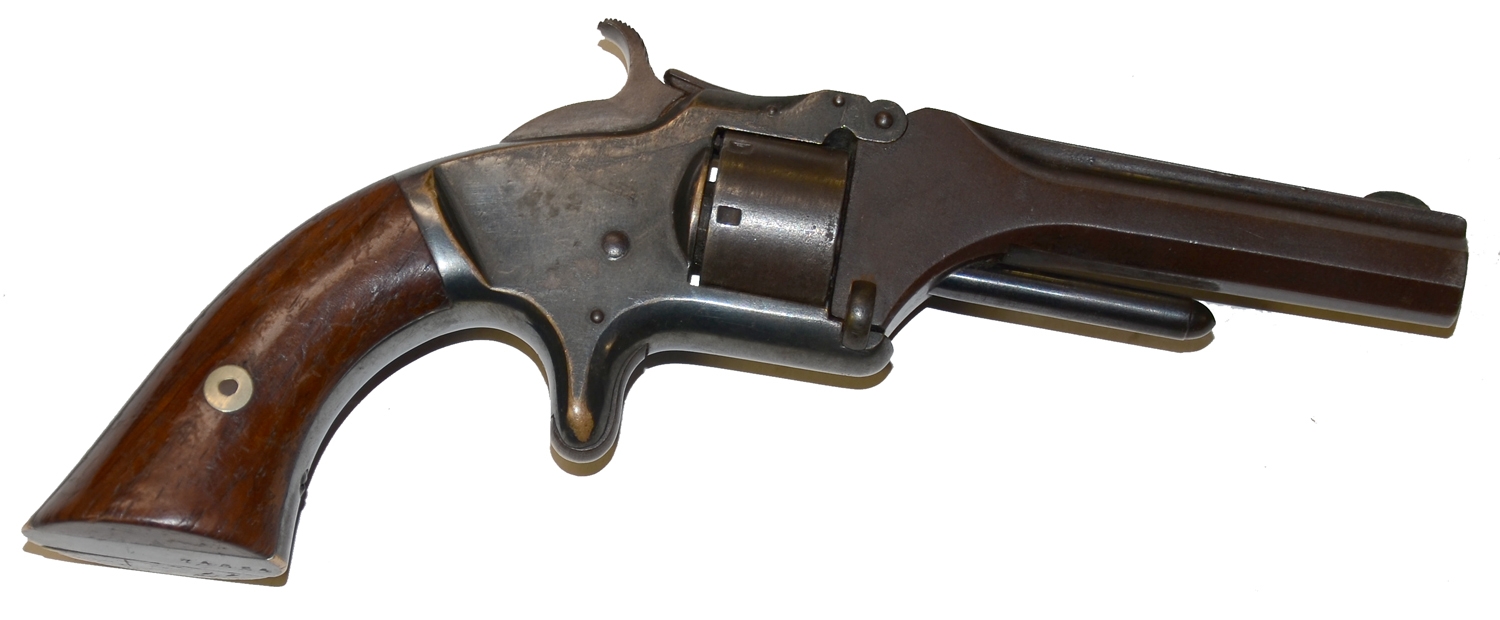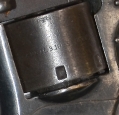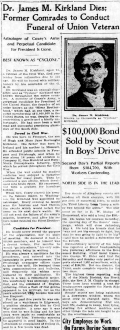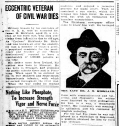site search
online catalog
NICE LOOKING INSCRIBED SMITH AND WESSON NO. 1 SECOND ISSUE REVOLVER: JAMES M. KIRKLAND, VETERAN OF THE 169th PA, AKA “CYCLONE KIRKLAND” OF PITTSBURGH, PA

$1,295.00 SOLD
Quantity Available: None
Item Code: 172-5582
This pretty pocket pistol has good finish remaining on the barrel, frame and engraved backstrap, very nice rosewood grips, and an interesting owner. These seven-shot .22 caliber pistols were made by Smith and Wesson from 1860 to 1868, picked up the serial numbering of the first issue patterns at about 11672 and ran up to about 128000 according to Flayderman or 126361 according to Burghoff. This one is numbered 74624, giving it an 1865 date of manufacture.
The markings are crisp: “Smith and Wesson Springfield, Mass.” The mechanics are good. There is good, even coverage of blue remaining, stronger in the channel of the barrel rib and muted elsewhere with expected gray along the edges of the octagon barrel and some thinning on the sides of the frame from handling. The grips have a nice fit and color. The back strap shows good color and a very nice script inscription: “J.M. Kirkland Pittsburgh Pa.” The quality of the pistol and the inscription is part of an interesting puzzle.
Kirkland is an interesting character, something like Pittsburgh’s equivalent of San Francisco’s Emperor Norton, a man with good prospects who some how went off the rails. Known later in life as both “Dr. James M. Kirkland” and “Cyclone Norton.” He was born 26 November 1843, one of seven children of Mary and Hugh Kirkland an Irish immigrant and “seceder clergyman,” pastor of a branch of the Presbyterian Church with an aversion to violations of the sabbath, profanity, use of charms, stage performances, slavery, secret societies, alcohol and “promiscuous dancing.” In 1850 the elder Kirkland was a pastor in Freeport, Beaver County, PA, and James attended schools in Freeport and Pittsburgh.
At age 18 in fall 1862 James joined the 169th Pennsylvania Volunteers, also known as the “169th Pennsylvania Drafted Militia,” organized in Pittsburgh in October and November 1862. Kirkland was officially enrolled October 16, mustering in Oct 25 as a private in Company E. The regiment served at Camp Howe in Pittsburgh until ordered to Washington 1 December 1862. From there it was sent to Fortress Monroe and then to Yorktown, where it was posted to Fort Keyes, across the river from Yorktown at Gloucester Point on Dec. 8.
As part of the 4th Army Corps the regiment took part in expeditions to Gloucester Court House 7 April 1863, and to Walkerton and Aylett’s June 4-5. From June 27 to July 7 they were part in Dix’s Peninsular Campaign, which aimed to take advantage of Lee’s move north and attack Richmond. Daniel Harvey Hill, however, fought to a standstill the faltering advances made by most of Dix’s forces, including a force under Keyes, in charge of the Yorktown garrison, which made an advance against Bottom’s Bridge.
In the wake of that unsuccessful offensive the regiment was ordered back to Washington and then to Funkstown, MD, where it became part of the 11th Corps, Army of the Potomac, in the pursuit of Lee to Williamsport. Once Lee had crossed into Virginia, the regiment moved to Harrisburg by way of Baltimore and Washington, with Kirkland officially mustering out there 25 July 1863.
One version of Kirkland’s postwar career has it that he studied medicine and had a lucrative practice, but at some point suffered sunstroke, resulting in “brain fever,” from which he developed, “a penchant for harmless foibles.” He supposedly joined Coxey’s Army, the 1894 protest march on Washington decrying government policies in the midst of a very large and long lasting depression, but appointed himself official astrologer for group. In Pittsburgh he founded “The Silent Brotherhood,” which he claimed to number five million, but did not furnish him many votes during his two presidential campaigns.
Records indicate he was a “journalist,” based on his occupation listed on a 1903 marriage license application, but he apparently filled out the application himself and both the profession and the bride were fanciful. He flooded local newspapers with “communications and bulletins,” which were sometimes published. One obituary noted that, “he could be seen hastening about the streets, his pockets bulging with huge rolls of newspapers and his face wrapt in study.” It was noted that he was, “in a way, a remarkable writer. His vocabulary was seemingly unlimited, and his command of English unfailing. Often a flash of real genius appeared in his writings, but as the years advanced, they became less and less frequent.” Our favorite obituary line is, “He was indifferent to his personal appearance, but his sincerity could never be doubted.” As to his prospective bride, a reporter disclosed that her address in Pittsburgh was a store and in Wilkinsburg, where Kirkland was actually working in a brickyard, it was a vacant lot.
What then of his medical career immediately after the war? This little pistol and its elegant inscription hint there might be something to the story. The newspaper report of his supposed engagment refers to him as “Dr. James M. Kirkland,” but says only that is how, “he writes his name on bank checks,” without saying whether the checks were good or not, so we are left guessing. If there is any bright side to the story it is the support given him by his G.A.R. comrades. They not only attended his funeral in 1918, but had secured for him in his later years a job as a watchman in Edgewood, a borough outside Pittsburgh and next to Swissville, where he died 29 April 1918. They also made sure to bury him with full military honors. This little pistol likely has more stories to tell. [sr]
DISCLAIMER: All firearms are sold as collector's items only - we do not accept responsibility as to the shooting safety or reliability of any antique firearm. All firearms are described as accurately as possible, given the restraints of a catalog listing length. We want satisfied customers & often "under" describe the weapons. Any city or state regulations regarding owning antique firearms are the responsibility of the purchaser. All firearms are "mechanically perfect" unless noted, but again, are NOT warranted as safe to fire!
~~~~~~~~~~~~~~~~~~~~~~~~~~~~~~~~~~~
THIS ITEM, AS WITH ALL OTHER ITEMS AVAILABLE ON OUR WEB SITE,
MAY BE PURCHASED THROUGH OUR LAYAWAY PROGRAM.
FOR OUR POLICIES AND TERMS,
CLICK ON ‘CONTACT US’ AT THE TOP OF ANY PAGE ON THE SITE,
THEN ON ‘LAYAWAY POLICY’.
THANK YOU!
Inquire About NICE LOOKING INSCRIBED SMITH AND WESSON NO. 1 SECOND ISSUE REVOLVER: JAMES M. KIRKLAND, VETERAN OF THE 169th PA, AKA “CYCLONE KIRKLAND” OF PITTSBURGH, PA
For inquiries, please email us at [email protected]
Most Popular
Historical Firearms Stolen From The National Civil War Museum In Harrisburg, Pa »
Theft From Gravesite Of Gen. John Reynolds »
Cavalry Carbine Sling Swivel »
Fine Condition Brass Infantry Bugle Insignia »
featured item
CAPTURED CONFEDERATE SECOND NATIONAL FLAG, UNUSUAL VARIATION WITH MADAUS LETTER, FROM A SOLDIER IN THE 59th NEW YORK
This 2nd National Confederate Flag was purchased in the 1980s by a well-respected Florida dealer/collector directly from descendants of the Union soldier who had kept it as a trophy. It comes with a 1988 letter on Milwaukee Public Museum letterhead… (1179-019). Learn More »












